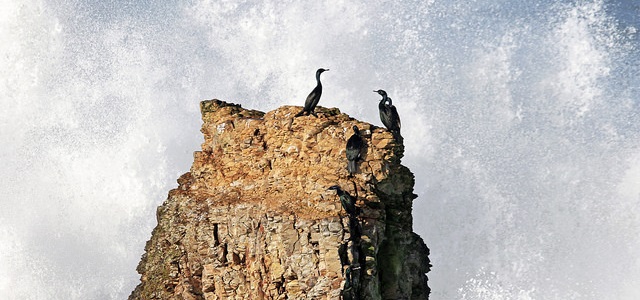Seabird Protection Network 
Point Sur – Point Mugu Chapter

Tips for Seabird Protection
How You Can Help
State and Federal laws protect seabirds and other marine life from disturbance and harassment. Being aware of wildlife around you is the key to preventing disturbance.
Remember! Breeding and roosting seabird species that nest or roost on cliffs or offshore rocks are highly susceptible to human disturbances.
To learn more about how you can be seabird safe, click on the tabs below according to how you recreate on the coast:
Boating
Approaching too close to seabird colonies causes birds to panic and fly, resulting in abandoned nests and potential decreases in seabird populations. Join fellow boaters and help protect seabirds by following these tips:
- Stay 1000' (roughly 3 football fields) away from cliffs, offshore rocks, and islands
- If you see birds reacting nervously (like head-bobbing, fluttering, calling or flying away) you are too close
- Paddle, sail, or motor around flocks of birds rather than through them
- Do Not Feed Wildlife
- Bring binoculars to enjoy watching seabirds from a safe distance
- Recycle or dispose of plastic items, fishing hooks, and fishing line in the trash - not in the water
- Cover your fishing bait
- Use barbless fishing hooks, artificial lures and weighted fishing lines to avoid hooking seabirds
- Never dump oil, fuel, or other foreign substances into the water or storm drains onshore
- Educate other boaters about boating and fishing seabird safe.
Hiking
Approaching too close to seabird colonies causes birds to panic and fly away, resulting in abandoned nests and potential decreases in seabird populations. Join fellow hikers and help protect seabirds by following these tips:
- Stay on the trail at all times, as one carelessly placed foot can damage underground nesting burrows
- If you see wildlife acting nervously you are too close; slowly back away and leave the area
- Pack out your trash
- Do Not Feed Wildlife
- Bring binoculars to enjoy watching seabirds from a safe distance
- Educate other hikers about hiking seabird safe.
Flying
Approaching too close to seabird colonies causes birds to panic and fly away, resulting in abandoned nests and potential decreases in seabird populations. Join fellow pilots and help protect seabirds by following these tips:
- Follow laws and safety guidelines that protect seabirds and your aircraft from harm
- 2000' AGL is recommended when flying within National Marine Sanctuaries
- Areas along the California Coast require a minimum 1000' AGL
- No direct flyovers or multiple passes are allowed in areas with sensitive wildlife
- Report violations to the NOAA Hotline 1-800-853-1964
- Educate other pilots about flying seabird safe.
Canoeing
Approaching too close to seabird colonies causes birds to panic and fly away, resulting in abandoned nests and potential decreases in seabird populations. Join fellow kayakers, canoers, and paddlers and help protect seabirds by following these tips:
- Stay 1000' (roughly 3 football fields) away from cliffs, offshore rocks, and islands
- If you see birds reacting nervously (like head-bobbing, fluttering, calling or flying away) you are too close
- Paddle around flocks of birds rather than through them
- Do Not Feed Wildlife
- Bring binoculars to enjoy watching seabirds from a safe distance
- Recycle or dispose of plastic items, fishing hooks, and fishing line in the trash - not in the water
- Cover your fishing bait
- Use barbless fishing hooks, artificial lures and weighted fishing lines to avoid hooking seabirds
- Never dump oil, fuel, or other foreign substances into the water or storm drains onshore
- Educate other kayakers, canoers, and paddlers about being seabird safe.
Photography
Approaching too close to seabird colonies causes birds to panic and fly away, resulting in abandoned nests and potential decreases in seabird populations. Join fellow photographers and help protect seabirds by following these tips:
- Stay off rocks at low tide when seabirds are present
- Photograph seabirds from a distance of at least 1000' (roughly 3 football fields)
- If you see birds reacting nervously (like head-bobbing, fluttering, calling or flying away) you are too close
- Educate other photographers about being seabird safe
Beach Combing and Dogs
Approaching too close to seabird colonies causes birds to panic and fly away, resulting in abandoned nests and potential decreases in seabird populations. Join fellow beachcombers and dog-walkers and help protect seabirds by following these tips:
- Keep your dog(s) on a leash at all times and out of the intertidal areas
- Keep your dog(s) from chasing birds at rest on the beach or rocky areas
- Be aware of seasonal or permanent closures of areas reserved for seabird protection
- Appreciate seabirds from a distance of at least 1000' (roughly 3 football fields)
- If you see birds reacting nervously (like head-bobbing, fluttering, calling or flying away) you are too close
- Stay off the rocks at low tide when seabirds are present
- Educate other beachcombers and dog owners about being seabird safe
Surfing
Approaching too close to seabird colonies causes birds to panic and fly away, resulting in abandoned nests and potential decreases in seabird populations. Join fellow surfers, swimmers, and divers and help protect seabirds by following these tips:
- Stay off rocks at low tide when seabirds are present
- Be aware of seasonal or permanent closures of areas reserved for seabird protection
- Stay 1000' (roughly 3 football fields) away from cliffs, offshore rocks, and islands
- If you see birds reacting nervously (like head-bobbing, fluttering, calling or flying away) you are too close
- Educate other surfers, swimmers, and divers about being seabird safe
